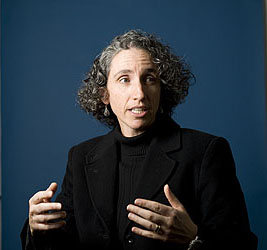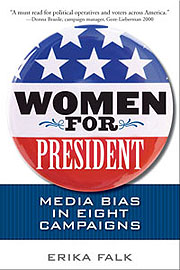
News Release
|
Office of News and Information Johns Hopkins University 901 South Bond Street, Suite 540 Baltimore, Maryland 21231 Phone: 443-287-9960 | Fax: 443-287-9920 |
January 8, 2008 FOR IMMEDIATE RELEASE CONTACT: Office of News and Information c&pa@jhu.edu 443-287-9960 |
Ninety-two percent of Americans say they would vote in a presidential election for a qualified female candidate from their own party, according to a February 2006 poll by CBS News and The New York Times. When asked if America is ready for a woman president, 55 percent of those surveyed said, "Yes," a figure that has been steadily rising since the middle of the 20th century.
So where is our woman in the White House?
A Johns Hopkins communications expert suggests that potential Madame Presidents running in past campaigns have been obscured in the press. As a result, female candidates haven't been as familiar to voters as male candidates, said Erika Falk, author of Women for President: Media Bias in Eight Campaigns (University of Illinois Press, Jan. 28, 2008) and associate program chair of the master of arts in communication in contemporary society program at Johns Hopkins.

Erika Falk
The book is especially topical during the 2008 presidential campaign, in which there has been considerable attention paid to the lone woman in the race, Sen. Hillary Clinton. Despite the fact that we see Clinton in print and on TV on a daily basis, Falk argues, the bias continues: The coverage isn't nearly as comprehensive, she says, as it is for Sen. Barack Obama.
 In Women for President, Falk analyzes gender bias in
press coverage of the presidential campaigns of Victoria
Woodhull (who ran in 1872), Belva Lockwood (1884 and 1888),
Margaret Chase Smith (1964), Shirley Chisholm (1972),
Patricia Schroeder (1988), Lenora Fulani (1988 and 1992),
Elizabeth Dole (2000) and Carol Moseley Braun (2004).
According to Falk's research:
In Women for President, Falk analyzes gender bias in
press coverage of the presidential campaigns of Victoria
Woodhull (who ran in 1872), Belva Lockwood (1884 and 1888),
Margaret Chase Smith (1964), Shirley Chisholm (1972),
Patricia Schroeder (1988), Lenora Fulani (1988 and 1992),
Elizabeth Dole (2000) and Carol Moseley Braun (2004).
According to Falk's research:
 Men
received more frequent and longer press coverage than women
in the same race, with men having twice the number of
stories written about them. The stories about the men were
also 7 percent longer.
Men
received more frequent and longer press coverage than women
in the same race, with men having twice the number of
stories written about them. The stories about the men were
also 7 percent longer.
 Stories about female candidates emphasized their physical
appearance and families. For the women, there were three
times as many physical descriptions (e.g., references to
clothing or a candidate's age) as their closest male
competitor in the race. Women were also stereotypically
portrayed as more emotional and their professional titles
were more likely to be omitted from stories.
Stories about female candidates emphasized their physical
appearance and families. For the women, there were three
times as many physical descriptions (e.g., references to
clothing or a candidate's age) as their closest male
competitor in the race. Women were also stereotypically
portrayed as more emotional and their professional titles
were more likely to be omitted from stories.
 Men
received much more substantive coverage, with 27 percent of
the paragraphs written about them focusing on issues. In
comparison, only 16 percent of the stories about the women
were based on the issues at hand.
Men
received much more substantive coverage, with 27 percent of
the paragraphs written about them focusing on issues. In
comparison, only 16 percent of the stories about the women
were based on the issues at hand.
 Even
if they polled at the same rate, men were more likely than
women to be portrayed as having a shot at winning, even
though they were just as likely to lose.
Even
if they polled at the same rate, men were more likely than
women to be portrayed as having a shot at winning, even
though they were just as likely to lose.
 Sometimes the different portrayals of women worked in their
favor: Though they received less coverage, women's quotes
were 14 percent longer and they received more frequent
references to their biographies and character, with 37
character depictions for every 10,000 words compared with
28 such depictions per 10,000 words for men.
Sometimes the different portrayals of women worked in their
favor: Though they received less coverage, women's quotes
were 14 percent longer and they received more frequent
references to their biographies and character, with 37
character depictions for every 10,000 words compared with
28 such depictions per 10,000 words for men.
"With the radical changes that have taken place for women in politics and journalism over the last 130 years, it is significant that the press portrayals of women candidates have not changed more," Falk says. "Although I found some differences in the press over time, the strongest trends did not show regular progress. Instead they suggested that women candidates from 1872 to 2004 were treated differently from their men counterparts, with women often getting the short end of the stick."
Falk believes that the same forces are at work in the 2008 campaign. From the beginning, she said, Obama has been more prominent in the press than Clinton: Both candidates announced their intentions to run for president in January 2007, and despite the fact that Clinton was higher in the polls from the start, the top six newspapers in the country ran 59 stories mentioning Obama in the headline that month compared to just 36 mentioning Clinton.
"In presidential campaigns, media portrayals are particularly important," Falk said. "Unlike lower-level races where interpersonal contact plays a central role, in presidential contests most of what constituents know about any candidate is learned from the media. Depending on the content, the media can encourage people to participate, engage, and become interested in the political process, or instead determine that the political process is not for them."
But the media's influence reaches beyond Clinton's run for the White House. "Another reason for us to be concerned is that the press coverage or lack thereof may have a chilling effect on women's desire to run," Falk says. "That is to say, the press, which tends to ignore women candidates and paints them in stereotypical ways, may deter women from running, and this may be the most significant problem in making gains for women in office."
Though her book was written before Clinton announced her run for president and doesn't study her campaign, Falk's work offers a historical perspective relevant to the 2008 election, where a woman is among the frontrunners for the Democratic nomination. As the race continues, Falk is available for interviews to talk about women and their quest for the White House. Her bio is online at http://advanced.jhu.edu/faculty/view/?id=56.
To speak with Falk, contact the staff of the Office of News and Information at (443) 287-9960 or c&pa@jhu.edu.
Note: The poll cited in the first paragraph is reported online here.
Related Web Sites
 Erika Falk podcast [mp3 format]
Erika Falk podcast [mp3 format]
 Publisher Web site
Publisher Web site


 Go to
Go to